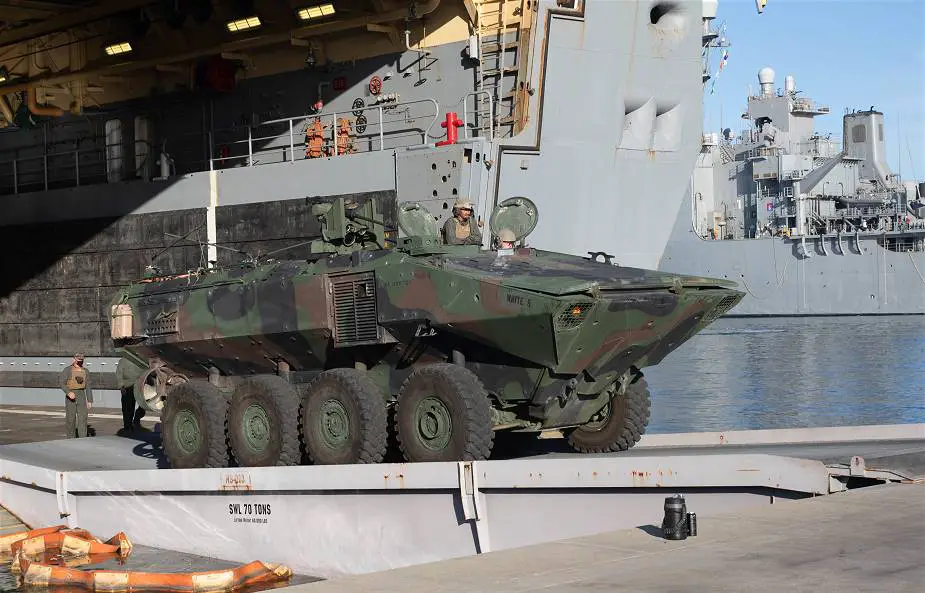Breaking news
BAE Systems receives new contract to produce ACV amphibious armored vehicles for US Marines.
According to information released on January 24, 2022, the U.S. Marine Corps has awarded BAE Systems a contract modification for the second lot of full-rate production of Amphibious Combat Vehicles (ACVs). The contract award of $ 169 million is for 33 vehicles.
Follow Army Recognition on Google News at this link

U.S. Marines offload amphibious combat vehicles (ACVs) with 3d Assault Amphibian Battalion, 1st Marine Division from the amphibious assault dock landing ship USS Anchorage (LPD 23) during a strategic mobility exercise (STRATMOBEX) at Naval Base San Diego, California, Oct. 19, 2021. (Picture source U.S. DoD)
The Amphibious Combat Vehicle (ACV) is a new generation of 8x8 amphibious armored vehicles designed and manufactured by BAE Systems in collaboration with the Italian company Iveco Defence Vehicles. The program to acquire a new amphibious armored vehicle was initiated in 2011 by the United States Marine Corps (USMC) to replace the old tracked amphibious armored vehicle AAV, official designation AAVP-7A1 which is in service with the U.S. Marine Corps since 1972.
In November 2015, BAE Systems received a $103.7m engineering, manufacturing, and development (EMD) contract to deliver 16 ACV prototypes. The first prototype under the contract was delivered to the USMC in December 2016. Delivery of the 16 prototypes was completed by the end of 2017.
BAE Systems received a $198m contract for the initial delivery of 30 ACVs in June 2018. The contract also includes options for the delivery of up to 204 vehicles, bringing the total contract value to $1.2bn.
BAE Systems was awarded the first full-rate ACV production Lot 1 contract option in December 2020 for the first 36 vehicles and the second option in February of 2021 for an additional 36 vehicles.
BAE Systems is already under contract to deliver two variants of the ACV Family of Vehicles to the Marine Corps: the ACV personnel variant (ACV-P) and the ACV command variant (ACV-C). The company has also received a design and development contract for a 30mm cannon variant (ACV-30), and a recovery vehicle (ACV-R) is also planned. In addition, BAE Systems has received task instructions from the U.S. Marine Corps to complete a study of incorporating Advanced Reconnaissance Vehicle Command, Control, Communication, and Computers/Unmanned Aerial Systems mission payload into an Amphibious Combat Vehicle (ACV) variant.
The ACV is an 8x8 amphibious armored vehicle and features a proven H-Drive System to deliver full-time all-wheel traction both on land and in the surf zone. Built to be exceptionally mobile, the ACV can maneuver in tight spaces and operate in any terrain or environment.
A blast-resistant hull and energy absorbing seats are key elements of the ACV’s survivability system that deliver superior mine, improvised explosive device (IED), kinetic energy (KE), and overhead protection. An Automatic Fire Suppression System is also included.
The ACV is powered by an Iveco Cursor 16 six-cylinder, 700 hp (515 kW) turbocharged and intercooled multi-fuel diesel engine, which develops 2213 lb. ft. (3000 Nm) of torque. The vehicle can reach a maximum speed of 105 km/h with a maximum cruising range of 523 km. The ACV is fully amphibious and powered in the water thanks to two waterjets mounted at the rear of the hull at a maximum speed of 11 km/h.
The ACV has a crew of three and can accommodate up to 13 military personnel. It has a gross vehicle weight of 35 tons with a maximum payload of 3,300 kg. The vehicle has an overall length of 9.2m, a width of 3.1 m, and a height of 2.9 m.




























